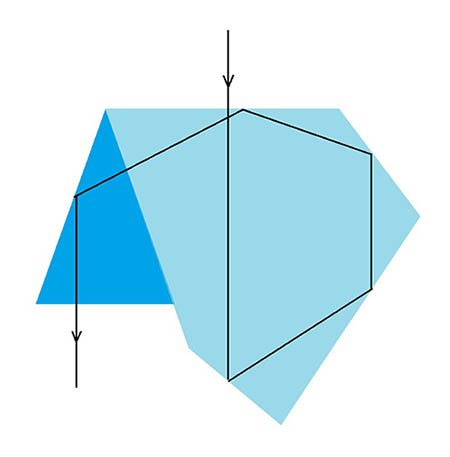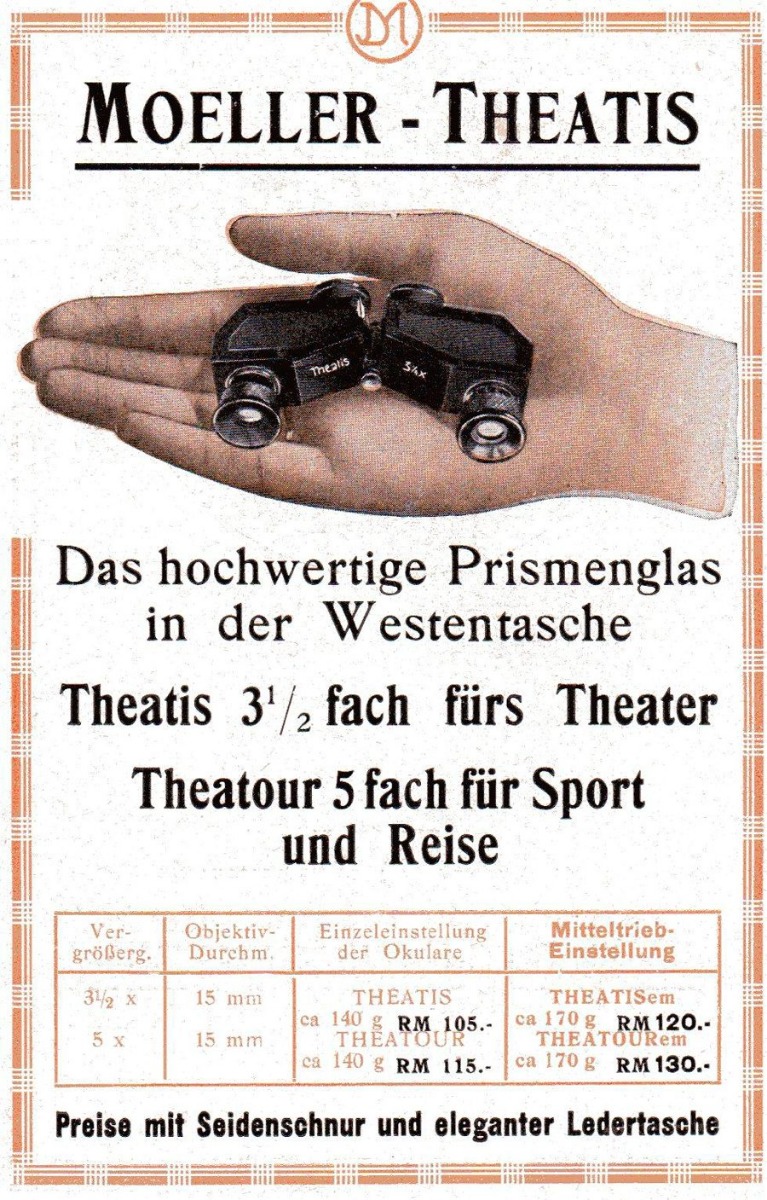Magnification: 6x
Aperture (objective diameter): 18 mm
Field of view: 8.3°
Outlet pupil diameter: 3 mm
The closest focusing distance: 2 m
Width: 10 cm
Height: 8 cm
Weight: 315 g
Production date: 1925.
Binoculars Carl Zeiss Jena Telita I 6x18
In 1920, the German optical firm J.D. Möller Optische Werke GmbH, founded in 1864, patents a new optical prism. It is a gluing of two parts (see picture).

Due to only two air-to-glass transitions, binoculars with such prisms had better contrast and higher light transmission (and therefore a brighter image) than binoculars with Porro prisms (four air-to-glass transitions).
J.D. Möller Optische Werke GmbH began to produce binoculars with new prisms, and based its advertising on the above fact: why buy more bulky and heavy binoculars on Porro prisms, if you can buy our compact and lightweight binoculars with the same high-quality image?

The management of Carl Zeiss Jena did not like this much: the vast majority of Carl Zeiss binoculars had Porro prisms. A lawsuit began between the two firms, which ended in victory ... J.D. Möller Optische Werke GmbH. This is one of the few cases where Carl Zeiss has lost a lawsuit.
Carl Zeiss engineers did not remain in debt, and in 1923, the "flat" compact Telita 6x18 binoculars appeared, structurally very similar to Möller's binoculars. But Carl Zeiss respected patent law and used the old scheme of prisms from the French company Huet as a turning system.
Telita 6x18 of the first generation (Telita I) had a central focus and flawless mechanical part. However, the optics turned out to be unsuccessful: unlike the competitor, the exit pupil was not round, but “cropped”. In this form, with minor changes (hull finishing materials), this device was produced until 1926. A total of 3,500 copies of this rather rare binocular were produced.
In 1926, the second generation of binoculars - Telita II - was released. It had the same optical characteristics, but it used different, slightly modified Möller prisms. The optical characteristics have improved significantly (it was possible to eliminate the “cropping” of the exit pupil), and the device was produced in this form until 1943. In addition, Carl Zeiss began to produce another model with Möller prisms - Turita 8x24.
Telita I has a central hinge, on the top washer of which the scale of interpupillary distances is applied, the magnification and aperture (objective diameter) of the binoculars are 6x18.
The eyepiece housings have a longitudinal knurling, the diameter of the base of the eyepieces is 18 mm. The height and width of the prism cases are 40.5 mm, and the thickness is 26.5 mm. The prism covers are attached to the body with four screws. The focus of the device is central. Lens diameter - 18 mm.
The inscriptions on the left cover of the prism body are "Carl Zeiss". On the right cover - "Telita 1251687". The inscription is printed in block letters against the background of a schematic image of a Carl Zeiss Tessar photographic lens. In addition, the covers of the prisms bear the inscription "AITCHISON LONDON": the binoculars were sold in the oldest English network of optics stores from Aitchison & Co. In 1927, Aitchison & Co merged with another prominent optical firm: Dollond & Co, to form Dollond & Aitchison (D&A for short).
The binoculars come with an original leather case (see photo)
The serial number of the binoculars is 1251687, it was made in 1925 in a large batch of 3000 pieces.
Carl Zeiss engineers did not remain in debt, and in 1923, the "flat" compact Telita 6x18 binoculars appeared, structurally very similar to Möller's binoculars. But Carl Zeiss respected patent law and used the old scheme of prisms from the French company Huet as a turning system.
Telita 6x18 of the first generation (Telita I) had a central focus and flawless mechanical part. However, the optics turned out to be unsuccessful: unlike the competitor, the exit pupil was not round, but “cropped”. In this form, with minor changes (hull finishing materials), this device was produced until 1926. A total of 3,500 copies of this rather rare binocular were produced.
In 1926, the second generation of binoculars - Telita II - was released. It had the same optical characteristics, but it used different, slightly modified Möller prisms. The optical characteristics have improved significantly (it was possible to eliminate the “cropping” of the exit pupil), and the device was produced in this form until 1943. In addition, Carl Zeiss began to produce another model with Möller prisms - Turita 8x24.
Telita I has a central hinge, on the top washer of which the scale of interpupillary distances is applied, the magnification and aperture (objective diameter) of the binoculars are 6x18.
The eyepiece housings have a longitudinal knurling, the diameter of the base of the eyepieces is 18 mm. The height and width of the prism cases are 40.5 mm, and the thickness is 26.5 mm. The prism covers are attached to the body with four screws. The focus of the device is central. Lens diameter - 18 mm.
The inscriptions on the left cover of the prism body are "Carl Zeiss". On the right cover - "Telita 1251687". The inscription is printed in block letters against the background of a schematic image of a Carl Zeiss Tessar photographic lens. In addition, the covers of the prisms bear the inscription "AITCHISON LONDON": the binoculars were sold in the oldest English network of optics stores from Aitchison & Co. In 1927, Aitchison & Co merged with another prominent optical firm: Dollond & Co, to form Dollond & Aitchison (D&A for short).
The binoculars come with an original leather case (see photo)
The serial number of the binoculars is 1251687, it was made in 1925 in a large batch of 3000 pieces.
